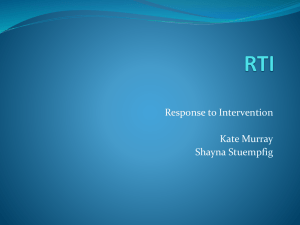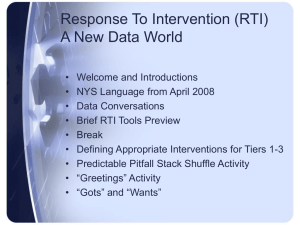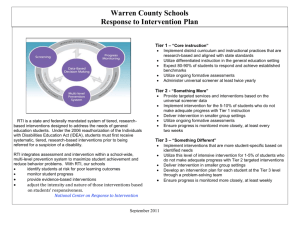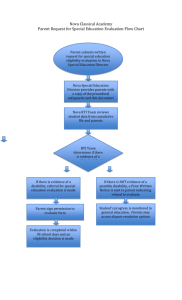INITIAL EVALUATION REFERRAL PROCEDURES A. RESPONSE
advertisement
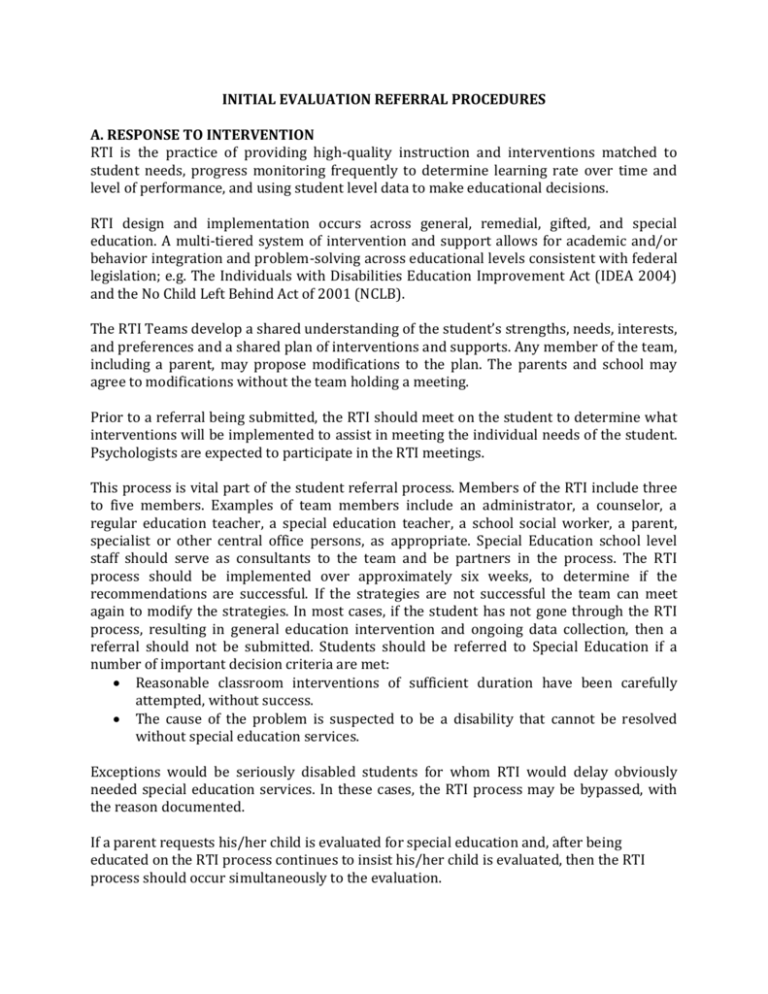
INITIAL EVALUATION REFERRAL PROCEDURES A. RESPONSE TO INTERVENTION RTI is the practice of providing high-quality instruction and interventions matched to student needs, progress monitoring frequently to determine learning rate over time and level of performance, and using student level data to make educational decisions. RTI design and implementation occurs across general, remedial, gifted, and special education. A multi-tiered system of intervention and support allows for academic and/or behavior integration and problem-solving across educational levels consistent with federal legislation; e.g. The Individuals with Disabilities Education Improvement Act (IDEA 2004) and the No Child Left Behind Act of 2001 (NCLB). The RTI Teams develop a shared understanding of the student’s strengths, needs, interests, and preferences and a shared plan of interventions and supports. Any member of the team, including a parent, may propose modifications to the plan. The parents and school may agree to modifications without the team holding a meeting. Prior to a referral being submitted, the RTI should meet on the student to determine what interventions will be implemented to assist in meeting the individual needs of the student. Psychologists are expected to participate in the RTI meetings. This process is vital part of the student referral process. Members of the RTI include three to five members. Examples of team members include an administrator, a counselor, a regular education teacher, a special education teacher, a school social worker, a parent, specialist or other central office persons, as appropriate. Special Education school level staff should serve as consultants to the team and be partners in the process. The RTI process should be implemented over approximately six weeks, to determine if the recommendations are successful. If the strategies are not successful the team can meet again to modify the strategies. In most cases, if the student has not gone through the RTI process, resulting in general education intervention and ongoing data collection, then a referral should not be submitted. Students should be referred to Special Education if a number of important decision criteria are met: Reasonable classroom interventions of sufficient duration have been carefully attempted, without success. The cause of the problem is suspected to be a disability that cannot be resolved without special education services. Exceptions would be seriously disabled students for whom RTI would delay obviously needed special education services. In these cases, the RTI process may be bypassed, with the reason documented. If a parent requests his/her child is evaluated for special education and, after being educated on the RTI process continues to insist his/her child is evaluated, then the RTI process should occur simultaneously to the evaluation. CORE PRINCIPLES OF RTI We can effectively teach all children Intervene early Use a multi-tiered model of service delivery Use a problem-solving method to make decisions within a multi-tiered model THREE ESSENTIAL COMPONENTS OF RTI 1. Multiple tiers of interventions and supports (a three tiered model is used in DCPS) 2. A problem solving method (Student Supports Teams are used in DCPS) 3. An integrated data collection/assessment system to inform decisions at each tier of service deliver Multi-Tiered Model of Supports Tier 1 – Universal Screening (all students) Schools use universal screening assessments to determine students’ level of reading proficiency; e.g., DIBELS, TRC. Teachers deliver Common Core State Standards for ELA and Math Teachers differentiate instruction within the core to meet a broad range of student needs (content, process, and product) Teachers use evidence based instructional strategies Teachers use behavior screeners to determine early identification of potential behavior problems Teachers develop and teach behavior expectations in conjunction with a schoolwide behavior system; e.g., PBIS, Responsive Classroom Tier 2 – Targeted interventions (small group or individuals) Supplemental instruction is provided to students not meeting benchmark expectations. Students receive academic or behavioral interventions matched to their skill deficits as identified by progress monitoring data Academic interventions, approved by the Office of the Chief Academic Officer, are provided in addition to the core instruction; e.g., Burst, Double Dose Foundations, Read 180 Behavioral interventions are provided in addition to teaching school-wide and class positive behavior expectations; e.g., Check In, Check Out (CICO), social skills groups by social worker or counselor Student Support Teams (SST) are used at the Tier 2 level to help develop, implement, and monitor targeted interventions Tier 3 – Intensive interventions (individual students) Individualized academic interventions are provided in addition to Tier 1 and Tier 2 academic supports; screenings, formative, and summative data are used to determine specific area(s) of skill deficits Individual behavioral interventions are provided in addition to Tier 1 and Tier 2 behavior supports; diagnostic assessments such as Functional Behavior Assessments (FBAs) are conducted to determine goals of misbehavior in order to develop behavior contracts or a Behavioral Intervention Plan (BIP) Student Support Teams are used at the Tier 3 level to help develop, implement, and monitor intensive, individualized interventions Notes of Importance: Tier 3 is not special education School Personnel School personnel play a number of important roles in RTI/MTSS – these roles will require new strategies and creative collaborative efforts focused on student data analysis to determine strengths and needs. Parents are essential to this process as well. Personnel needed to support RTI/MTSS include, but are not limited to administrators, teachers, coaches, psychologists, and related services providers. Psychologists At the universal Tier 1 of RTI, school psychologists should: Assist with identifying students who are struggling with academic or behavioral age or grade level expectations Conduct a thorough review of student documentation Assist or facilitate student focused data-based discussions Consult with teachers and parents regarding early intervention strategies in the classroom and at home Consult with district personnel to identify appropriate evidence-based intervention strategies Conduct classroom observations and confer with the students’ teachers Determine useful and appropriate procedures for concerns and needs of students At the targeted Tier 2 of RTI, school psychologists should: Observe students in the instructional environment to help identify appropriate learning interventions or barriers to interventions Demonstrate, model, and train intervention strategies Develop, model, and train staff on data collection strategies to monitor fidelity of interventions Attend SST meetings and contribute to the decision making process Participate in the SST intervention plan development Serve as liaison to parents by helping them understand the SST intervention plan Engage in ongoing consultation regarding implementation Review data and documentation to assess intervention fidelity, integrity, and intensity At the intensive Tier 3 of RTI, school psychologists should: All of the above Review data and Tier 2 interventions to determine if student progress has been actualized or if interventions need to be more intensive Participate in SST discussion for the need to continue with SST process or if testing may be warranted Serve as liaison to MDT if testing is warranted RSPs are expected to document the suggested interventions in the Provider Management Application (PMA). The PMA is accessible through Quickbase by accessing the following website: https://www.octo.quickbase.com B. ROLE OF THE STUDENT SUPPORT TEAM (SST) The SST meets during the Tier II of the Rti process. The team should meet on a regular basis and develop more individualized intervention strategies for the students who continue to experience academic and/or behavioral difficulties despite Tier I interventions. School Psychologists are expected to serve as members of SST. As a member of the SST, strategies are provided to the teacher and parent to address the identified areas of concerns. In addition, tier 3 RTI interventions, strategies and techniques may be required. If the SST process is not successful in addressing the identified concerns, the student should be referred for an assessment. C. VISION/HEARING SCREENING All of the medical information in the student’s file should be reviewed prior to the assessments being ordered. Vision and hearing screenings are completed by the school nurse or the child’s doctor. The student must have a vision and hearing screening completed within one year of the day the psychologist’s assessment is started. If either screening is failed, appropriate measures must be taken (parent notified, audiological assessment obtained, glasses prescribed, etc.) in an attempt to correct the problem before the student can be evaluated. If it is ascertained that a vision or hearing impairment cannot be corrected or has been corrected to the extent that it can be, this information should be recorded within the Analyzing Existing Data section of SEDS during the evaluation process. D. EVALUATION TO DETERMINE ELIGIBILITY When the RTI team determines that a Psychological evaluation is necessary, a referral for evaluation will be initiated. Prior to making a referral for evaluation, the above areas must be addressed. Also, the student’s difficulties must have been discussed with his/her parents and educational interventions must have been implemented and found to be unsuccessful. The referral form should be submitted with collected data on the student’s response to Intervention, which is completed by the school-level SST members, with information collected from a variety of sources. It is extremely important that the referral form is completed completely and correctly. When bilingual students are referred for evaluation, the Request for Bilingual Assessment Form must be completed before the psychologist signs the referral form. It is important to note that exact dates (month, date, and year) must be included for each conference, observation, and intervention listed on the referral. E. ELIGIBILITY PROCESS: OVERVIEW Requesting an Evaluation Any interested person (a parent, the SEA, another state agency, or school district personnel) may initiate a request for an initial evaluation (IDEA, 1414 (a)(1)(B)Please note that Evaluations are different than Assessments The IEP and qualified professionals analyze existing data, determine if additional tests are required, interpret all evaluation data and determine eligibility based on the data. Referral When a parent requests a referral, the LEA should complete the “STANDARD INITIAL REFERRAL FORM”. This form is to be completed by only by a DCPS LEA/Case Manager, who collects information from the person making the referral and completes the form. Information entered on the form should reflect information gathered from the stakeholder making the referral. The completed form should be faxed into SEDS under Miscellaneous Cover Sheet. The referral date on the form should be entered as the referral date in SEDS. This date starts the 120-day timeline. Exception to Timeline The 120 day timeframe does not apply to an LEA if: The parent of a child repeatedly fails or refuses to produce the child for the evaluation; The parent fails or refuses to respond to a request for consent for the evaluation or A child enrolls in a school of another LEA after the 120-day timeline has begun, and prior to the determination by the child's previous LEA as to whether the child is a child with a disability under this policy. This only applies if the subsequent LEA is making sufficient progress to ensure a prompt completion of the evaluation, and the parent and subsequent LEA agree to a specific time when the evaluation will be completed. The LEA and/or RSP must document in SEDS all reasonable efforts made to contact the parent regarding evaluation appointments, requests for consent, or its progress on completing the evaluation as outlined above. Reasonable efforts are defined as a minimum of three attempts and multiple modalities as outlined in the OSSE reevaluation policy (e.g. phone and mailed correspondence) by the LEA. The LEA and/or RSP must document in SEDS all reasonable efforts made to contact the parent regarding evaluation appointments, requests for consent, or its progress on completing the evaluation as outlined above. Reasonable efforts are defined as a minimum of three attempts and multiple modalities as outlined in the OSSE reevaluation policy (e.g. phone and mailed correspondence) by the LEA. A child enrolls in a school of another LEA after the 120-day timeline has begun, and prior to the determination by the child's previous LEA as to whether the child is a child with a disability under this policy. This only applies if the subsequent LEA is making sufficient progress to ensure a prompt completion of the evaluation, and the parent and subsequent LEA agree to a specific time when the evaluation will be completed. The LEA and/or RSP must document in SEDS all reasonable efforts made to contact the parent regarding evaluation appointments, requests for consent, or its progress on completing the evaluation as outlined above. Reasonable efforts are defined as a minimum of three attempts and multiple modalities as outlined in the OSSE reevaluation policy (e.g. phone and mailed correspondence) by the LEA. Analyzing Existing Data The analyzing existing data step of the evaluation process should be completed to determine whether or not there is sufficient information to make an eligibility determination or if formal assessments are needed to make a determination. This review must be conducted by group of individuals that include required members of an IEP Team and Review existing evaluation data Information provided by parent Classroom-based observations Response to Intervention in the General Education setting Information provided by the teachers Formal and informal assessments The IEP team should begin their review of the referral by analyzing as many of the following types of existing data as are available: Attendance Behavior or Incident Reports Classroom observations Class work samples Current grades Discipline Reports Documentation of academic and behavior interventions Evaluations and information provided by parents Health Records and Medical Reports Report cards Standardized Test Scores Identify the data that is needed to determine: Category of disability Present levels of performance Special education & related services Modifications to allow child to meet IEP goals & participate in general education The student’s progress Documentation of this review must include: The team conclusions/decisions The date the conclusions/decisions are finalized The names of individuals participating in the review Conclusion if additional assessments are needed Parental Consent for Assessment DCPS must obtain informed parental consent prior to evaluation or providing special education services and must make reasonable attempts to get consent of parents of children who are wards of the state. The expert in the area of assessment should always be present at the time informed consent is obtained. Informed consent stems from the legal and ethical right the parent has to decide what is done to his or her child, and from the provider's ethical duty to ensure that the parent is involved in decisions. The process of ensuring informed consent includes information exchange between the school and parent and is a part of parent education. In words the parent can understand, the provider must convey the details of a procedure, the purpose of the procedure and any associated assessments. The parent should be presented with information on the most likely outcomes of treatment. LEAs must order all assessments in SEDS within three days of procuring the parental consent. The LEA is not required to obtain parental consent for the initial evaluation when the child is a ward of the State and is not residing with the child's parent and the conditions under 34 C.F.R. 300.300(a)(2) are met. For more information, consult the OSI reference guide at https://sites.google.com/a/dc.gov/office-of-special-education-reference-guide/ Ordering Assessments Based on the analysis of existing data, the team determines if additional formal assessment are required to make an eligibility determination. If they are required, case managers are required to order those assessments within 3 business days of obtaining consent. If a parent refuses consent: For evaluation: the agency may use due process to obtain authority for evaluation For services: the agency may NOT use due process in seeking to provide services; there is no fault to the public agency, and no IEP meeting is required No single procedure may be the sole criterion and a legally constituted team per IDEA must make the decision. To address the specific areas of concern, a variety of assessment tools & strategies must be used to collect functional and developmental information that may assist in determining: Whether the child has a disability The content of the IEP To accomplish this, assessment materials must be: Non–discriminatory Given in the child’s native language or mode of communication Administered by trained personnel in conformity with instructions Conducted to reflect of the student’s aptitude or achievement Used to assess all areas related to the suspected disability and areas of concern Technically and culturally sound instruments to assess Cognitive & behavioral factors Physical & developmental factors Non-Discriminatory Assessments “Assessment is defined in DCMR as a data collection procedure to examine a particular area of need in accordance with the rules in IDEA and DCMR. This procedure must be used by a group of qualified professionals to determine a child's educational needs and eligibility for special education and related services.” Tests selected & administered must not be racially or culturally discriminatory Ensure that the test used is valid with your population by reading the data provided in the manual. Interpreting Evaluation Data Draw on information from a variety of sources Decisions must be documented and carefully considered Decisions must be made by the MDT/IEP team Placement decisions must be accordance with LRE requirements Identification Prior to any student being identified and receiving services the school shall conduct a full and individual evaluation (IDEA, 20 U.S.C. 1414(a)(1)). The assessment tools should assist the team in both determining eligibility and specific educational programming. Six Principles of IDEA Principle of IDEA Zero Reject Protection in Evaluation Free Appropriate Public Education Least Restrictive Environment Procedural Safeguards Parental Participation Requirement Locate, identify, & provide services to all eligible students with disabilities Conduct an assessment to determine if a student has an IDEA related disability and if he/she needs special education services Develop and deliver an individualized education program of special education services that confers meaningful educational benefit. Educate students with disabilities with nondisabled students to the maximum extent appropriate. Comply with the procedural requirements of the IDEA. Collaborate with parents in the development and delivery of their child’s special education program. Procedures for Initial Assessment There is a 45-day timeframe from receipt of parental consent for initial assessment until the initial evaluation is completed. The timeframe does not apply if: The child attends a new school district after consent is given but before the evaluation is conducted; or The parent fails to, or repeatedly refuses to, produce the child for evaluation Ensure that all assessments are completed within 45 days of securing parental consent! The assessment report must be uploaded into SEDS using a Psychological Assessment Report SEDS cover sheet (not a miscellaneous cover sheet). All Providers will receive a weekly automatic notification including a report with the following information: A list of all psychological assessments ordered at their respective schools Student information Parent Consent Date, Assessment Order Date, Assessment Due Date Details indicating which assessments are OVERDUE Coming Due in 10 Days Open If you are experiencing issues with uploading your document please contact the SEDS office and send a copy of the report to your PM and LEA via email prior to it becoming overdue. The HOD Assessment process Compliance Case Managers (CCM) will emails LEA and provider within 2 calendar days of receiving signed HOD A copy of the HOD and requirements for the Local School should be included in the email Specifications identifying if it is an IEE Review, SA or HOD should be included (protocol should be followed in ordering in SEDS). CCM ensures that the assessment has been ordered correctly by reviewing in SEDS within 2 calendar days Special Case Assessment Request There are types of assessments that require conducting initial screenings or assessments prior to determining a specialty assessment is necessary. A psychological assessment must be conducted and results must clearly present the need for more specialized data collection in order for psychiatric and neuropsychological assessments to be requested. All psychiatric and neuropsychological assessment requests must be sent to the Psychology Program Managers via email prior to obtaining parental consent and ordering in SEDS. Prior to ordering in SEDS, the following information must be sent and await approval: 1. Psychological Assessment 2. Anecdotal Notes (specify justification for evaluation) 3. Medical documentation if available 4. Attach Referral Form to email Eligibility Determination Policy An eligibility “determination is premised upon whether the child has one of the designated disabilities under the IDEA and the DCMR and, as a result of that disability, requires special education and related services. To make this determination, a team consisting of a group of qualified professionals and the parent must consider all reports of assessments procedures, including a review of informal and formal assessments, parent information, health records, and other independent evaluations”. The team must consider two questions to make an eligibility determination: 1) Does the team have enough data to make an eligibility determination? 2) Does the student qualify for special education and related services under IDEA? Special Rules for Determining Eligibility in IDEA 2004 A child will not be determined to be a child with a disability if the basis of the child’s problem is lack of scientifically based instruction in reading, math or written language. Multidisciplinary Team The MDT consists of the following: Parents Special education teacher Local Education Agency (LEA) representative Student (of appropriate age); Evaluator (school psychologist, speech pathologist, occupational therapist, physical therapist, adaptive physical education teacher, etc.) General education teacher Related service provider(s) (where appropriate) Others involved with providing services to the student (where appropriate) in or outside of the school setting (e.g., community mental health service provider, courtappointed social services worker, etc.). Triennial Reevaluation Policy Procedures A reevaluation is understood to be a comprehensive evaluation analogous to an initial evaluation under 34 CFR 300.301, conducted for students who have already undergone evaluations and been found eligible for services. A three-year re-evaluation should answer the questions: ¨Is the student is still eligible for services under IDEA? ¨What is the student’s present level of academic achievement and functional needs ¨What additions or modifications to the special education services are needed Is there a change to the student’s eligibility classification? When a student’s academic and functional needs warrant it, a reevaluation should be performed more frequently than three years. **A new Cognitive Assessment is rarely necessary at a re-evaluation, as standardized assessments utilized in Psychological Assessments are typically more appropriate in determining initial eligibility and classification. Psychological Triennial Evaluations are typically generated for Triennials. Circumstances in which an Assessment should be conducted, include: Existing data does not provide the key data points needed to determine eligibility or disability classification, e.g., the team believes the student was inappropriately classified as ED, and requires adaptive testing to determine if ID is more appropriate. The provider determines that the previous assessment(s) is inaccurate. The parent requests it after the team has explained the lack of utility of the new assessment. HOD requires it. Independent Education Evaluations (IEE) Policy and Procedure A parent may choose to get an independent assessment of their child at their own expense at any time. A parent may also request independent evaluation if the parent disagrees with the DCPS assessment. Other sources for IEEs include those: ordered by Hearing Officer Decision (HOD) agreed to in a Settlement Agreement (SA) ordered by a judge in a Child and Family Service Agency (CFSA) or juvenile proceeding The most frequent situation is when a parent disputes an evaluation conducted by DCPS and wants an IEE at public expense. A request for an IEE at DCPS expense should usually be granted when a parent disputes a DCPS evaluation. The determination of whether to authorize an IEE or initiate a due process claim must be made within 5 calendar days of the request. Section 504 Referrals The Section 504 regulations require a school district to provide a "free appropriate public education" (FAPE) to each qualified student with a disability who is in the school district's jurisdiction, regardless of the nature or severity of the disability. Under Section 504, FAPE consists of the provision of regular or special education and related aids and services designed to meet the student's individual educational needs as adequately as the needs of nondisabled students are met. If a student has a disability that impacts their ability to access their education, the 504 process can begin without referring to Special Education. However, sometime a student will be evaluated for Special Education and found to have a disability but not require Special Education. A student may need accommodations to access his or her education. In this case, the student will be referred to the Section 504 process. In either case the School Psychologist may be called upon to complete the necessary evaluations, which may be used to determine if there is a disability that impedes the student’s ability to access their education. MANIFESTATION DETERMINATION REVIEW A Manifestation Determination Review (MDR) is a meeting to assess whether or not a child’s behavior that led to a disciplinary removal is linked to his or her disability. The IDEA allows school administrators to apply short-term disciplinary removals of students with disabilities and students suspected of having disabilities for up to ten consecutive school days or ten accumulated school days throughout the course of the school year without conducting a MDR. Any removal beyond ten consecutive days or ten accumulated days is considered a change in placement for the student. IDEA stipulates that within 10 school days of any decision to change the placement of a child with a disability because of a violation of a code of student conduct, the local educational agency, the parent, and relevant members of the IEP Team (as determined by the parent and the local educational agency) shall review all relevant information in the student's file, including the child's IEP, any teacher observations, and any relevant information provided by the parents to determine; (I) if the conduct in question was caused by, or had a direct and substantial relationship to, the child's disability; or (II) if the conduct in question was the direct result of the local educational agency's failure to implement the IEP. If the local educational agency, the parent, and relevant members of the IEP Team determine that either sub-clause (I) or (II) is applicable for the child, the conduct shall be determined to be a manifestation of the child's disability. A MDR is an evaluation of the student’s disability and the act of misconduct, when a district proposes to remove the student or enact specified disciplinary actions. The district, the parent and relevant members of the IEP team conduct the MDR. If a School Psychologists was a member of the student’s IEP team it is strongly recommended that they participate in the MDR. Disciplinary actions can be made only if the IEP team concludes after the review that there was no relationship between the student’s disability and the actions of misconduct.



